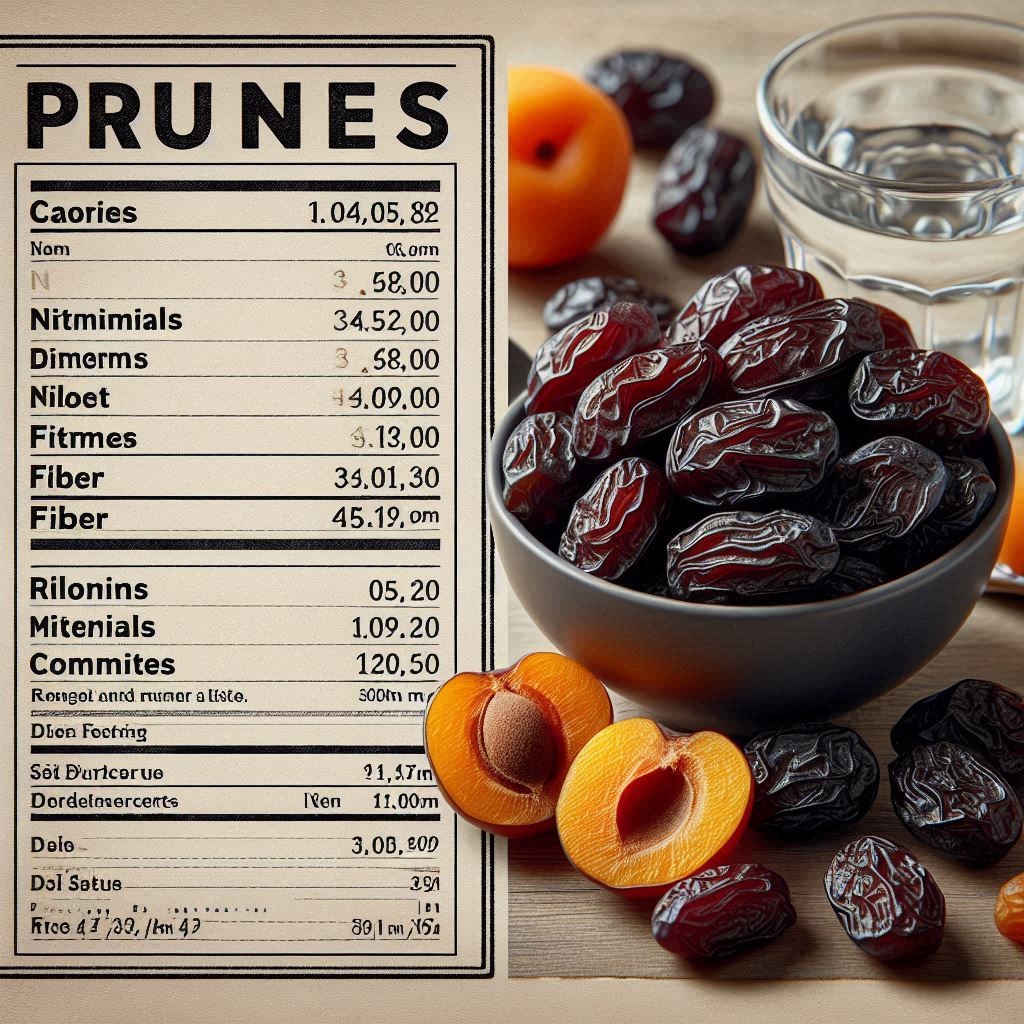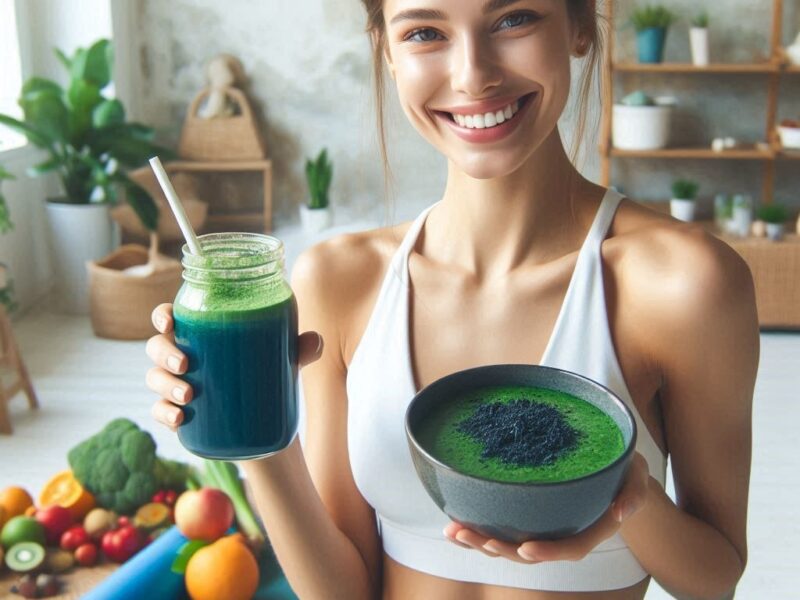
Prunes: A Nutritional Powerhouse
Introduction
Prunes, also known as dried plums, are not just a delicious snack but also a nutrient-dense food with numerous health benefits. This article explores the various health benefits of prunes, including their impact on digestion, bone health, cardiovascular health, and more.
Nutritional Profile of Prunes
Prunes are rich in essential nutrients such as vitamins, minerals, and antioxidants. A 100-gram serving of dried plums provides:
- Calories: 240
- Carbohydrates: 63.9 grams
- Fiber: 7.1 grams
- Sugars: 38.1 grams
- Protein: 2.2 grams
- Vitamin K: 59.5 micrograms (74% of the Daily Value)
- Vitamin A: 781 International Units (16% of the Daily Value)
- Potassium: 732 milligrams (21% of the Daily Value)
- Copper: 0.4 milligrams (45% of the Daily Value)
- Boron: 1.18 milligrams
Health Benefits of Prunes
Digestive Health
Prunes are well-known for their natural laxative effect, which can help alleviate constipation. This is due to their high fiber content and the presence of sorbitol, a sugar alcohol with laxative properties. The fiber in dried plums adds bulk to the stool and helps it pass more easily, while sorbitol draws water into the intestine, softening the stool and promoting regular bowel movements.
Bone Health Benefits of Prunes
Prunes are beneficial for bone health due to their high content of vitamin K, potassium, and boron. Vitamin K plays a crucial role in bone mineralization, while potassium helps neutralize acid load, reducing calcium loss from bones. Boron, a trace element found in dried plums, also supports bone health by influencing calcium and magnesium metabolism. Studies have shown that consuming prunes can help increase bone mineral density, particularly in postmenopausal women and osteoporosis.
Cardiovascular Health Benefits Of Prunes
Prunes contribute to heart health in several ways. They are rich in potassium, which helps regulate blood pressure, and fiber, which helps lower cholesterol levels. Additionally, dried plums contain antioxidants like phenolic compounds that help reduce oxidative stress and inflammation, both of which are risk factors for cardiovascular diseases. Regular consumption of prunes has been associated with lower LDL (bad) cholesterol levels and improved overall heart health.
Blood Sugar Control
Despite their natural sweetness, prunes have a low glycemic index (GI), meaning they do not cause a rapid spike in blood sugar levels. This is attributed to their high fiber content, which slows down the digestion and absorption of sugars. As a result, prunes can be a suitable snack for individuals with diabetes or those looking to manage their blood sugar levels.
Antioxidant Properties
Prunes are packed with antioxidants, including vitamin C and various phytonutrients such as phenolic compounds. These antioxidants help protect cells from damage caused by free radicals, potentially reducing the risk of chronic diseases such as cancer. Prunes have been found to have higher antioxidant activity than many other fruits, making them a powerful addition to a healthy diet.
Skin Health
The antioxidants and vitamins in prunes also contribute to healthier skin. Vitamin A, in particular, is essential for maintaining healthy skin and mucous membranes. It helps in the growth and repair of skin tissues, while antioxidants protect the skin from oxidative damage caused by UV rays and pollution.
Weight Management
Prunes can aid in weight management due to their high fiber content, which promotes a feeling of fullness and helps control appetite. The fiber in dried plums slows down the digestion process, reducing overall calorie intake. Additionally, it provides natural sweetness without added sugars, making them a healthier alternative to sugary snacks.
Prunes, also known as dried plums, are made through a multi-step process that involves harvesting, drying, and sometimes additional processing to ensure quality and safety. Here is a detailed explanation of how prunes are made:
1. Selection of Plum Variety
The process starts with the selection of the right variety of plums. Typically, dried plums are made from the European plum variety (Prunus domestica), which has a higher sugar content and suitable texture for drying compared to other plum varieties.
2. Harvesting
Prune growers harvest plums when they reach full ripeness. This ensures they have the maximum natural sugar content and the best flavor. Prune growers usually harvest the plums mechanically in large-scale operations to actively ensure efficiency and minimize damage to the fruit.
3. Washing and Sorting
Once prune growers harvest the plums, they actively wash them thoroughly to remove any dirt, debris, or pesticides. After washing, they sort the plums based on size and quality, selecting only the best ones for the drying process.
4. Drying Process
The drying process is crucial in making prunes. There are two primary methods used:
- Sun Drying: This traditional method involves spreading the plums on large drying trays and leaving them under the sun for several days. Prune growers actively turn the plums regularly to ensure even drying. This traditional method is still used in some regions, particularly where the climate is suitable for this process.
- Mechanical Drying: In modern production, mechanical drying is more common. The plums are placed in large dehydrators where they are exposed to controlled heat and airflow. This method is faster and more efficient, ensuring a consistent product. The temperature and humidity levels are carefully controlled to preserve the nutrients and natural sugars in the plums.
5. Pitting
After the drying process, prune growers actively pit the plums. In some cases, they sell prunes with pits, but most commercial dried plums are pitted for convenience.” The pitting process involves cutting the dried plums open and removing the pits mechanically.
6. Additional Processing
Depending on the desired end product, dried plums may undergo additional processing. This can include:
- Rehydration: Prune producers may partially rehydrate the prunes to actively achieve a specific moisture content, making them softer and more palatable.
- Pasteurization: To ensure safety, prune producers sometimes actively pasteurize the dried plums to kill any harmful bacteria or pathogens.
- Packaging: Finally, prune producers actively package the dried plums in airtight containers to preserve freshness. Packaging can range from bulk containers for industrial use to consumer-friendly packs for retail sales.
7. Quality Control
Throughout the production process, quality control measures are implemented to ensure that the prunes meet safety standards and quality specifications. This includes regular testing for moisture content, sugar levels, and microbial contamination.
The process of making prunes transforms fresh plums into a shelf-stable, nutrient-dense dried fruit that can be enjoyed year-round. Whether using traditional sun-drying methods or modern mechanical drying, the goal is to produce dried plums that retain their natural sweetness, rich flavor, and health benefits.
For more detailed information on prune production, you can visit:
- California Dried Plums
- Agricultural Marketing Resource Center
Faq’s For Prunes
General Information about dried plums
Prunes are dried plums, typically of the European variety, that have been dehydrated to remove most of their moisture content. They are known for their rich flavor and health benefits.
Prunes are dried plums. The drying process concentrates the nutrients and sugars, making dried plums a denser source of vitamins and minerals compared to fresh plums.
Prune allergies are uncommon but can occur. Some individuals may experience oral allergy syndrome, where the immune system reacts to proteins in the fruit similar to pollen.
Nutritional Content
dried plums are rich in fiber, potassium, vitamin K, vitamin B6, and several antioxidants. They also contain small amounts of calcium, magnesium, and iron.
A typical serving of prunes (about 4-6 dried plums) contains approximately 100 calories, making them a nutrient-dense snack.
Prunes contain natural sugars but also have a low glycemic index due to their high fiber content, which helps regulate blood sugar levels.
Health Benefits
dried plums are an effective remedy for constipation due to their high fiber content and natural sorbitol, which act as a mild laxative.
Yes, dried plums are beneficial for bone health. They contain vitamin K, boron, and phenolic compounds that help prevent bone loss and improve bone density, especially in postmenopausal women.
dried plums contribute to heart health by reducing cholesterol levels and providing potassium, which helps regulate blood pressure. They also contain antioxidants that reduce inflammation.
dried plums are high in fiber, which helps keep you full longer and can aid in weight management by reducing overall calorie intake.
Usage and Consumption
Consuming 5-6 dried plums daily is recommended to gain their digestive and bone health benefits without excessive calorie intake.
Yes, due to their low glycemic index and high fiber content, dried plums can be part of a diabetic diet. They help manage blood sugar levels and provide essential nutrients.
Prunes can be eaten as a snack, added to cereals, baked into bread, or used in cooking savory dishes like stews and salads.
Special Considerations
Eating too much dried plums can lead to digestive issues such as bloating, gas, or diarrhea due to their high fiber and sorbitol content.
Yes, prunes are safe and beneficial for children, especially in preventing constipation. However, portion sizes should be adjusted according to their age and nutritional needs.
Conclusion
Incorporating prunes into your diet can offer a wide range of health benefits, from improved digestion and bone health to better heart health and blood sugar control. Their rich nutritional profile and antioxidant properties make them a valuable addition to a balanced diet. Whether eaten as a snack or added to various dishes, dried plums are a delicious and nutritious choice for promoting overall health.
Recommended External Links
- National Osteoporosis Foundation: Foods Rich in Vitamin K
- American Heart Association: Benefits of Potassium
- National Institute on Aging: Antioxidants and Your Health
These links provide additional information on the nutritional benefits and health impacts of prunes without competing with the primary content of this article.

One thought on “Prunes: Health Benefits, Nutrition, Uses (2024 Guide)”